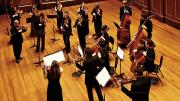Mounted on the wall of the botánica next door, where the devout can buy incense and saints’ images, painted statues of angels stare into the rented storefront in Jamaica Plain where A Far Cry rehearses. Having someone to watch over them could help the members of the young chamber orchestra make their way in the classical music world, and its crowded Boston scene—especially since these 17 violinists, violists, cellists, and double bassists play without a conductor’s guiding hand. But the grace of this leaderless (and, as they admit, “highly opinionated”) crew is no divine gift; it’s a deep trust, cultivated over time.
Founded in 2007, A Far Cry has recorded six albums. They tour the country and abroad, in addition to giving regular concerts at home—at the New England Conservatory (NEC), at St. John’s Church in Jamaica Plain, and at the Isabella Stewart Gardner Museum, where they have been Chamber Orchestra in Residence since 2010. This season’s first concert at NEC’s Jordan Hall, Return to the Idyll, opened with a suite by contemporary British composer Thomas Adés. Across its seven movements, A Far Cry filled the space with unsettled and percussive pizzicato, then made the voices of their instruments rise and intertwine sinuously—all without a baton to cue them in or dictate tempo. “Watching them is like watching a player piano,” one audience member remarked. Their performances can have the same hypnotic effect as the sight of ivory keys moved by an invisible hand. The musicians observe one another closely, registering each other’s breaths and gestures. Violinist Jae Young Cosmos Lee, one of the group’s co-founders, describes this attunement to fellow players as akin to “wearing them on the outside of your skin.”
Three Harvard alumni play in A Far Cry: violist Sarah Darling ’02 and violinists Miki-Sophia Cloud ’04 and Alex Fortes ’07. All three played in the self-conducting, still-kicking Brattle Street Chamber Players (BSCP) as undergraduates. Fortes remembers the ensemble fondly, but also recalls how its rehearsals could devolve into “very little playing and a lot of talking.” Darling’s experience with the challenges of the BSCP and groups like it colored her first reaction to the “Criers” when, as an NEC master’s student, she heard they had formed: “I smiled to myself and thought, ‘Oh, haha, we’ll see how that goes—you guys don’t know what you’re in for.’ ” Then she attended one of their concerts, and discovered a group “so gorgeously in sync with each other and the music—everyone dreaming about Beethoven in just the same way.”
No group of this size and kind could come so far without some rules. In earlier years, rehearsals sometimes became free-for-alls, getting feisty and then derailed, as members quarreled over how to play a particular work. These days, A Far Cry runs like the high-functioning parliament of a small country. Each work has a new set of principals—one leader from each instrumental section—who lead the group’s practice. Only a principal may stop a run-through. Then, the floor opens to any two musicians who wish to comment on an issue small enough to be quickly addressed—a few bars, a particular phrase. Because of this system, a rehearsal for a single concert can shift styles from hour to hour. One set of principals may tape up a diagram of a Mozart divertimento, to help the group visualize its shape. Another team, leading a Stravinsky concerto, may narrate a scene to evoke a desired mood, instructing everyone to imagine “Romeo first setting his eyes on Juliet—‘I see you, I want to dance around you, feel you out.’ ” On rare occasions, the Criers appoint a “spanker,” a member empowered to unilaterally cut off a discussion, or just to yell. They follow equally civil procedures to determine the year’s concertmaster, programming, and distribution of principal parts.
This fall, A Far Cry launched their own recording label, Crier Records, with their first concept album. Miki-Sophia Cloud conceived of Dreams and Prayers as an exploration of mysticism, and of music’s role in humanity’s relationship to the divine. It spans three religious traditions: a sequence from medieval Christian abbess Hildegard von Bingen’s The Origin of Fire, played by the violins in monody; a commission from Turkish composer Mehmet Ali Sanlıkol, inspired by Sufism; and a new arrangement of Jewish composer Osvaldo Golijov’s The Dreams and Prayers of Isaac the Blind. It also includes one of Cloud’s favorite pieces, Beethoven’s String Quartet No. 15, “Heiliger Dankgesang,” written after the composer had recovered from a long illness. In the liner notes, she writes about how, before each concert, she freed the audience of their obligation to clap politely. They could sit in silence to absorb the last notes of a piece as it faded—or, as some did during the livelier works, get up, clap, and whoop.
The Criers’ eighth season will include their first live-streamed concert, and—in a decision debated at length—the first time they will ever be conducted, as they collaborate with composer Matthew Aucoin ’12 on an opera at the American Repertory Theater. Darling and Lee say that A Far Cry feels more like a “thirties group” than a “twenties group,” but also that aging has made the orchestra more, not less, experimental. When skirmishes break out in rehearsal, they’re easier to control. “The worst thing you can do,” explains Lee, “is take two striking views and average them.”
The wild urgency of their youth, when any season could be their last, has ebbed away. A Far Cry can look toward a longer future together than they’d dared to hope for. As Darling says: “Your repertoire of sounds increases, the longer you stand on the earth.”
Update: Dreams and Prayers has been nominated for a Grammy Award. Read more about the album, and Crier Records' recent projects, here.










